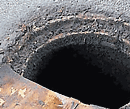
The Centre for Science and Environment, in a report, has tore apart the Bruhat Bangalore Mahanagara Palike (BBMP)’s projection of facade of development with an unrealistic budge. The report brings out the City’s failure to manage its sewage and precious water. CSE director Sunita Narain aptly puts it, “Bangalore is drowning in its own excreta.”
Sunita was quick to emphasise that Bangaloreans were by no means “unique”. At the launch of the seventh edition of the CSE State of India’s Environment Report titled ‘Excreta Matters’, she said cities across the country were doing equally bad. By neglecting sewage, its treatment, recycle and re-use, urban India was not only allowing wastage of water but also polluting water resources.
“Bangalore too, having turned its back to a very scientific design of its water-sewage system given to it by its initial developers, has found itself in a sad state of affairs, killing lakes and unable to manage water and sewage. But you are not alone or unique. Cities across India are in a bad shape when it comes to sewage treatment and mangement of water,” she said.
The report is based on a survey of 71 Indian cities and how they have managed their water and sewage, including three cities of Karnataka, Bangalore, Tumkur and Hubli-Dharwad.
Cities always plan for water, never for waste, Sunita said. Bangaloreans must understand that 80 per cent of the water that flows into homes here goes as sewage. Water generates waste, therefore, more water means more sewage which must be accounted for. Sunita was clear that cities, including Bangalore had no clue how they will convert the waste, treat it and clean rivers.
Bangalore has 3,610 km of underground drainage in the core area alone and the city generates about 800-1,000 million litres of sewage a day. “The city has 14 sewage treatment plants with a capacity to treat 781 million litre a day, not too far from the sewage generated but it only treats about 300-400 litre a day as the remaining is not even sent to the plants. That is the tragedy,” she pointed out.
The remainder of the sewage is just mixed with the water bodies in the city, polluting them. She said Bangalore’s underground water have shown traces of nitrate. “This is not an agricultural area, so the nitrate content is a clear indication of sewage.”